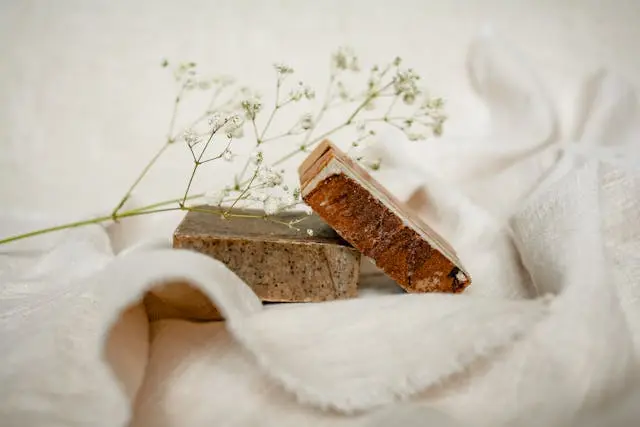À l'heure où la tendance est à la réduction des déchets et au retour au naturel, il est bon de faire du tri dans votre salle de bain. Les gels douches et autres produits cosmétiques en contenant plastique peuvent être remplacés efficacement par des pains de savon, naturel et bio.
Non seulement vous maîtrisez ce que vous appliquez sur votre peau mais en plus, vous faîtes votre part de colibri dans la responsabilisation de la protection de l'environnement.
Le savon, un pollueur des eaux
Le savon est fait pour nettoyer alors comment pourrait-il polluer les eaux ? Et bien disons que la composition des gels douches non certifiés bio est plus que douteuse.
Pour beaucoup, des ingrédients tels que les parabens qui sont des perturbateurs endocriniens se retrouvent déversés dans les canalisations qui ensuite passent la barrière de la filtration dans les centres de décontaminations des eaux avant de finir dans les fleuves et les océans.
À grande échelle, ces perturbateurs modifient les organismes des poissons, font mourir les coraux, détruisent les fonds marins...
De plus, les contenants en plastiques sont mal recyclés et finissent par se désintégrer en micro-billes de plastique qui seront avalées par les animaux marins (oiseaux, poissons, tortues etc...)
Le plastique crée une pollution sans précédent. Il faut agir chacun à son niveau. Opter pour des pains de savons est votre part de colibri.
Les savons artisanaux, soutenir le commercer local
De nombreuses entreprises artisanales et familiales ont vu le jour. Elles ont développé un savoir-faire et une exigence de qualité qui est à la hauteur des plus grands standards. En choisissant d'acheter des savons artisanaux, vous vous engagez à soutenir ces micro-entreprises parfois fragiles.
On parle souvent de consommer éthique et consommer local est un acte eco-citoyen.
Des pains de savon pour un retour au naturel
Les savons durs n'ont pas besoin de conservateur, d'agent texturant, de parfums de synthèse etc... De la matière brute, naturelle et de qualité suffisent à créer un excellent produit sans polluer la nature et sans nuire à votre santé.
Pour le transporter en voyage, il existe des petites boîtes ou vous pouvez même utiliser un récipient avec couvercle de votre cuisine.
En revanche, veillez à le maintenir au sec après utilisation au risque de le voir fondre entre deux nettoyage...
L'histoire du savon
On raconte une légende selon laquelle le savon serait né sur le Mont Sapo tout près de Rome sur laquelle les Romains avaient pour coutume de sacrifier des animaux.
Les cendres des feux de bois et la graisse des animaux auraient alors formé les prémices d'un savon.
Lorsque ce mélange se jetait dans le cours d'eau dans lequel les Romaines lavaient leur linge, elles remarquèrent que les tâches partaient plus facilement à cet endroit là.

Le nom de cette montagne donna le nom latin du savon.
Cependant, historiquement, le savon aurait existé 3000 ans avant J.-C. à l'époque des Sumériens. Ils avaient déjà découvert le principe de la saponification en mélangeant de la graisse et des cendres bouillies.
En 1500 avant J.-C, pendant l'Egypte Antique, le natron et le carbonate de soude servaient à la toilette.
« Pourtant, selon Pline l’Ancien (23 -79 après JC), le savon dur a été inventé par les Gaulois qui le fabriquaient à partir de cendres, de suif et de saindoux ou d’huiles non comestibles. Il était alors principalement utilisé pour laver les cheveux. »
Recette DIY savon
Voici la recette pour fabriquer votre savon maison. Vous pouvez la retrouver sur notre e-shop. Elle vous permettra de créer un savon surgras, c’est-à-dire plus riche en huile qu’en soude.
Pour plus de sécurité, il vous est conseillé de vous munir d’un tablier et éventuellement de lunettes pour vous protéger de possibles projections. Il vaut mieux utiliser des récipients en verre lors de la réalisation de savon.
ATTENTION ! La soude est un ingrédient dangereux et est à garder hors de portée des enfants.
Le port de gants est obligatoire durant toute la préparation pour éviter entrer en contact direct avec la soude.
N’oubliez pas de bien laver les gants à la fin avant de les retirer.
Ingrédients
- 100 g d’huile de coco.
- 100 g de beurre de karité.
- 135 g d’huile de colza.
- 45,5 g de soude caustique.
- 117 g d’eau.
Préparation
- Faites fondre le beurre de karité au bain-marie. Quand tout est fondu, ajoutez-y les huiles et mélangez pour obtenir un mélange homogène.
- Dans un même temps, dans un autre bol ajoutez doucement la soude dans l’eau. Attention aux éventuelles projections qui pourraient vous brûler. !! Ne jamais faire le contraire, c’est-à-dire ajouter l’eau dans de la soude !!
- Lorsque les deux préparations ont refroidi jusqu’à température ambiante, versez le mélange de soude dans les huiles.
- Mixez la préparation jusqu’à l’apparition d’une texture légèrement épaisse. Vous pouvez alors y ajouter des ingrédients optionnels (huiles essentielles, parfums, colorants… mais attention aux quantités !)
- Quand tout a été mélangé, versez la préparation dans un moule puis couvrez le de cellophane.
- Après 48h vous pouvez démouler votre savon.
- Laissez le reposer dans un endroit très sec pendant 6 semaines avant de l’utiliser.



